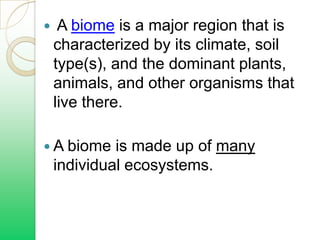Report
Share

Recommended
Recommended
More Related Content
What's hot
What's hot (20)
Similar to Biomes
Similar to Biomes (20)
Which of the following sets of biomes is placed in order from lowest.pdf

Which of the following sets of biomes is placed in order from lowest.pdf
Forest and its importance, Management and land uses.pdf

Forest and its importance, Management and land uses.pdf
t3-g-93-world-biomes-and-climate-zones-powerpoint_ver_6.ppt

t3-g-93-world-biomes-and-climate-zones-powerpoint_ver_6.ppt
More from mlong24
More from mlong24 (20)
Recently uploaded
Recently uploaded (20)
Automating Google Workspace (GWS) & more with Apps Script

Automating Google Workspace (GWS) & more with Apps Script
Connector Corner: Accelerate revenue generation using UiPath API-centric busi...

Connector Corner: Accelerate revenue generation using UiPath API-centric busi...
Apidays New York 2024 - The value of a flexible API Management solution for O...

Apidays New York 2024 - The value of a flexible API Management solution for O...
From Event to Action: Accelerate Your Decision Making with Real-Time Automation

From Event to Action: Accelerate Your Decision Making with Real-Time Automation
Strategies for Unlocking Knowledge Management in Microsoft 365 in the Copilot...

Strategies for Unlocking Knowledge Management in Microsoft 365 in the Copilot...
Boost Fertility New Invention Ups Success Rates.pdf

Boost Fertility New Invention Ups Success Rates.pdf
Powerful Google developer tools for immediate impact! (2023-24 C)

Powerful Google developer tools for immediate impact! (2023-24 C)
TrustArc Webinar - Unlock the Power of AI-Driven Data Discovery

TrustArc Webinar - Unlock the Power of AI-Driven Data Discovery
Tech Trends Report 2024 Future Today Institute.pdf

Tech Trends Report 2024 Future Today Institute.pdf
Apidays New York 2024 - Scaling API-first by Ian Reasor and Radu Cotescu, Adobe

Apidays New York 2024 - Scaling API-first by Ian Reasor and Radu Cotescu, Adobe
HTML Injection Attacks: Impact and Mitigation Strategies

HTML Injection Attacks: Impact and Mitigation Strategies
[2024]Digital Global Overview Report 2024 Meltwater.pdf![[2024]Digital Global Overview Report 2024 Meltwater.pdf](data:image/gif;base64,R0lGODlhAQABAIAAAAAAAP///yH5BAEAAAAALAAAAAABAAEAAAIBRAA7)
![[2024]Digital Global Overview Report 2024 Meltwater.pdf](data:image/gif;base64,R0lGODlhAQABAIAAAAAAAP///yH5BAEAAAAALAAAAAABAAEAAAIBRAA7)
[2024]Digital Global Overview Report 2024 Meltwater.pdf
Scaling API-first – The story of a global engineering organization

Scaling API-first – The story of a global engineering organization
Bajaj Allianz Life Insurance Company - Insurer Innovation Award 2024

Bajaj Allianz Life Insurance Company - Insurer Innovation Award 2024
2024: Domino Containers - The Next Step. News from the Domino Container commu...

2024: Domino Containers - The Next Step. News from the Domino Container commu...
Biomes
- 1. A biome is a major region that is characterized by its climate, soil type(s), and the dominant plants, animals, and other organisms that live there. A biome is made up of many individual ecosystems.
- 2. Types of Biomes Tundra Desert Grassland Coniferous forest Temperate deciduous forest Tropical rainforest
- 3. Is the temperature of each Biome: Hot, moderate, or cold? Tundra - Desert - Grassland - Coniferous forest - Temperate deciduous forest - Tropical rainforest -
- 4. Is the temperature of each Biome: Hot, moderate, or cold? Tundra - Cold Desert - Hot Grassland - Moderate Coniferous forest - Cold Temperate deciduous forest - Moderate Tropical rainforest - Hot
- 5. Climate • Weather conditions over a long period of time
- 6. Latitude and Altitude Affect the Climate Gets colder the higher up you go (altitude) Gets colder the farther north/south of the equator you go (latitude) Most of food on Earth is grown between 30-60 degrees north and south of the equator -- Do we live in this latitude??--
- 7. Tundra
- 8. Tundra Arctic tundra can be found in Antarctica and the North Pole, North of the Arctic Circle. Grass, lichen and herbs Permafrost – layer of soil that is always frozen. Very short warm season that is very wet Many insects during warm season
- 10. Coniferous forest Is one of the most fragile biomes Spruce and Fir trees Found in Northern Hemisphere Growing season very short Nearly constant daylight in summer Many lakes and swamps
- 12. Temperate Deciduous Forest Climate and amount of sunlight can vary tremendously between each season. Deciduous trees lose their leaves in fall.
- 13. Grassland
- 14. Grasslands Grasslands are characterized by their tall, perennial grasses and lack of trees. 2 Types 1. Tropical grasslands: between the Tropic of Cancer and the Tropic of Capricorn, hot year-round, very dry, season of heavy rain. 2. Temperate grasslands: north of the Tropic of Cancer or south of the Tropic of Capricorn, cold winters and hot summers. Cover a quarter of the land on Earth
- 15. Desert • Deserts take up 8.6 million square miles on Earth.
- 16. Desert Get less than 25 cm of rain each year Has little or no vegetation Driest places on earth Often located on the dry side of mountain ranges
- 19. Tropical Rainforest Contain over half of the world's plant and animal species live here. All fit into only 7 percent of the world's land. Found in: Central Africa, Southeast Asia, Philippines, New Guinea, Central and South
- 20. Tropical Rainforest Layers: Top – Emergent layer – tallest trees above rest of forest Next – Canopy – top of normal trees Lower canopy – epiphytes – plants that grow on tree trunks – not soil - because light is so far from ground. Understory – lowest level, much darker
- 21. Climatograms A climatogram is a graph that shows average monthly values for two factors: temperature and precipitation. Temperature is expressed in degrees Celsius and is plotted as a smooth curve. Precipitation values are given in centimeters and are plotted as a histogram.